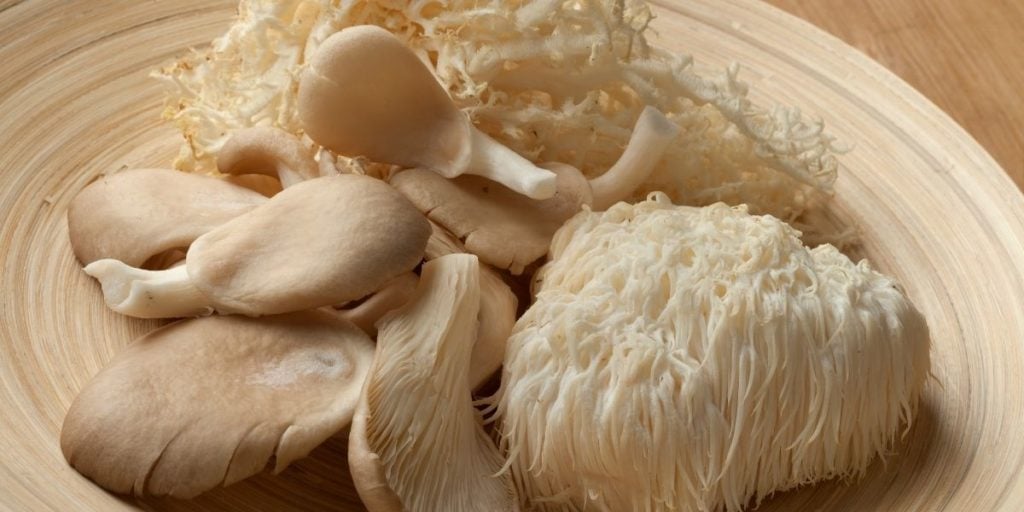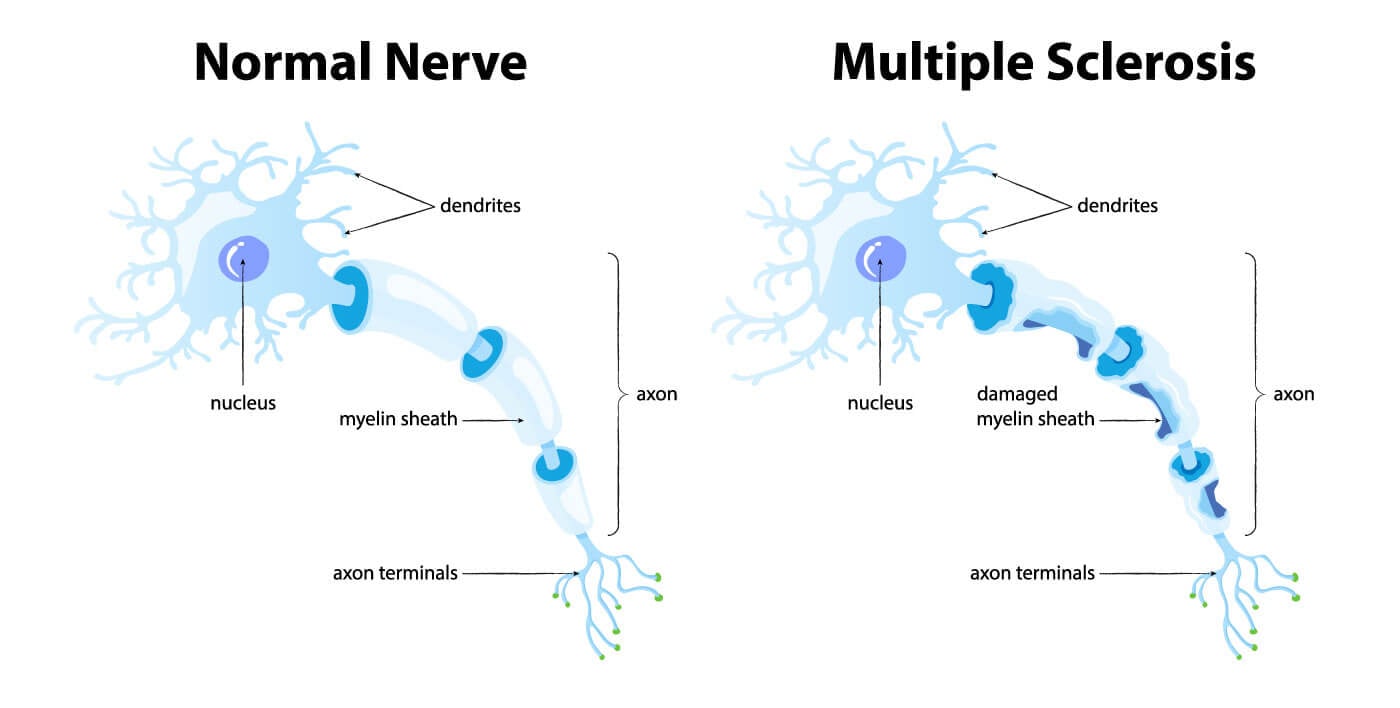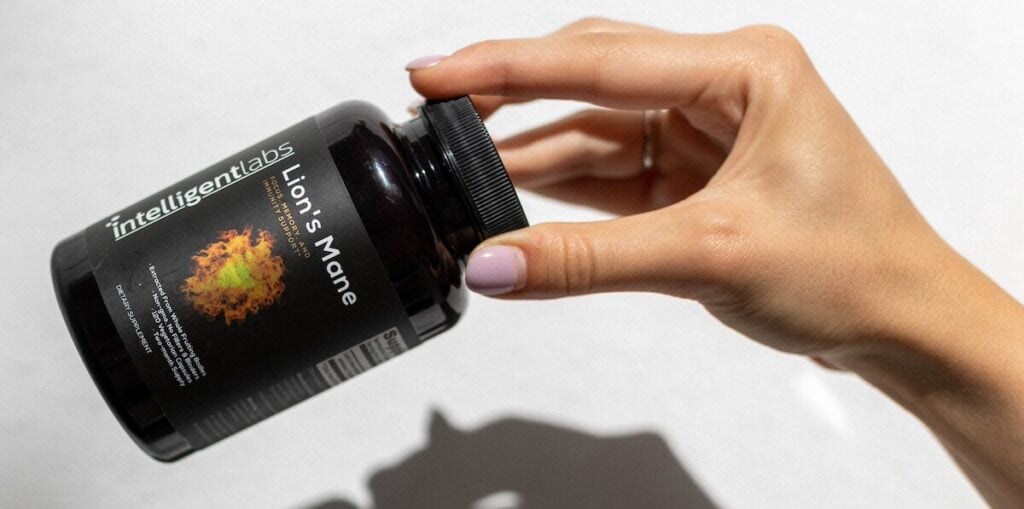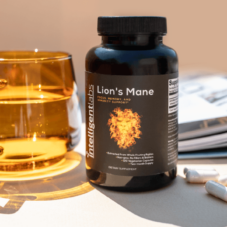Nootropics
Lion’s Mane: Tasty Mushrooms with Cognitive Health Benefits
Delicate, tender, juicy, and meaty… these are but a few words used to describe the taste of Lion’s Mane mushrooms. But its benefits go beyond the palate. As you’ll soon learn in this article, they also have scientifically-backed cognitive health benefits!
Table of Contents
What is Lion’s Mane Mushroom?
Lion’s Mane, aka Hericium Erinaceus, must win the prize for the coolest-looking medicinal plant. It has flowing ‘locks’ similar to a lion’s, which is where the name comes from.

It is edible (check out these mushroom recipes), grows on trees, and belongs to the tooth fungus group. In China, people call it Monkey Head Mushroom, and in Japan, it’s known as Yamabushitake.
Modern researchers have found that Lion’s Mane contains special compounds like hericenone A, hericenone B, xylan, glucoxylan, and heteroxyloglucan.
These compounds are powerful; they can boost brain function, support the immune system, and even stimulate the growth of neurons.
So, it turns out this mushroom is not just interesting to look at, but could also be good for your health! Check out our Ultimate Guide To Lion’s Mane Mushroom supplements to learn more about this amazing shroom!
What are the health benefits of Lion’s Mane Mushroom?
1) Lion’s Mane may help boost NGF production
Prior to the 1990s, the brain benefits of Lion’s Mane were mostly anecdotal. Then, Dr. Hirokazu Kawagishi led groundbreaking research showing it could boost the production of Nerve Growth Factor (NGF).
NGF is crucial for brain cell growth, repair, and forming new connections.1 However, NGF can’t directly enter the brain from the bloodstream; it must be made inside the brain. Luckily, Lion’s Mane can help with this.
Dr. Kawagishi’s findings were confirmed 15 years later by Mori et al.2 Additionally, a study by Kolotushkina revealed that Lion’s Mane can also promote the growth of myelin sheaths,3 which are vital for quick electrical signal movement in the brain. Damage to these sheaths is linked to Multiple Sclerosis (see image below).

2) Taking Lion’s Mane might make your memory better
Alzheimer’s disease causes a big drop in thinking skills because of harmful plaques in the brain. Research by Mori and his team showed that this mushroom could help. They found that mice with Alzheimer’s improved in memory tests after eating the mushroom daily.4
They also studied older adults with mild memory problems, giving them Lion’s Mane powder thrice daily for 16 weeks. These people did better on memory tests than those who didn’t take the mushroom. However, their memory scores dropped after they stopped taking it for four weeks.5
Other studies, like Wong’s, showed that the mushroom helped rats with nerve damage regain leg function.6
Brandalise found that healthy mice did better in memory tasks and had more brain cells in the memory-related area after taking Lion’s Mane.7 This suggests the mushroom could also support brain health, memory, and other cognitive functions.
3) Lion’s mane may support immune system health
Lion’s Mane mushroom can help modulate the immune system. If the immune system is too active and causing excessive inflammation, it calms it down. But if it’s too weak, the mushroom helps fight off the infection better.
For example, a study in 2017 showed that Lion’s Mane boosts the activity of important immune cells like lymphocytes, macrophages, and natural killer cells in mice. It also increased the production of a key antibody in the gut, helping protect against illness. 8
4) It could also improve your mood and make you feel less anxious
Lion’s Mane mushroom might help with inflammation in the body, and also make people feel less depressed and anxious.

So, the immune system uses cytokines like TNF-α to increase inflammation and IL-10 to reduce it, helping to prevent damage after fighting off infection.
A 2015 study by Yao showed that Lion’s Mane increased IL-10 and decreased TNF-α in mice, reducing inflammation.9 These mice also showed fewer signs of depression during tests commonly used to assess mood in animal studies.
Another study found that stressed mice had lower levels of TNF-α and another inflammation marker, IL-6, when given Lion’s Mane. This suggests the mushroom might help turn off genes that cause inflammation.10
Additionally, a study on 30 menopausal women found that taking Lion’s Mane for four weeks reduced their feelings of depression and anxiety.11 This research points to Lion’s Mane as a potential mental health aid.
Related article: What are nootropics and cognitive enhancing supplements?
5) This mushroom may help with heart health
Lion’s Mane mushroom might be good for the heart, too. Research with rats and mice shows it can improve heart health markers.
For example, Choi and team found that rats on a high-fat diet had better cholesterol levels when they added Lion’s Mane to their diet. They had lower bad fats, lower overall cholesterol, and higher good cholesterol.12
Another study by Mori and colleagues showed that Lion’s Mane made blood cells less likely to stick together and form clots in rabbits.13
6) It may also help manage diabetes
Lion’s Mane mushroom could be helpful for people with diabetes. Liang’s research on diabetic rats showed that the mushroom lowered blood sugar and boosted insulin, which helps manage diabetes by improving how the body uses insulin and makes it in the pancreas.14
Diabetes often leads to peripheral neuropathy, causing pain and numbness in the limbs. Yi’s study found that treating diabetic rats with Lion’s Mane for six weeks reduced nerve pain and helped lower blood and urine sugar levels.15
Conclusion
Lion’s Mane mushroom has shown impressive health benefits. As we’ve learned, it may stimulate NGF, slow cognitive decline, provide nootropic benefits, boost immunity, and even help manage diabetes.
Every 2-capsule serving of our Lion’s Mane Mushroom Extract delivers 1,000mg of pure mushroom. It’s standardized to contain at least 25% beta glucans, aiming to offer the full spectrum of this mushroom’s health advantages!
💬 Something on your mind? Share your thoughts in the comments. We love hearing from curious minds.
📩 And while you’re here, join our newsletter for more smart stuff (and secret perks)!
References:
- NGF Is Essential for Hippocampal Plasticity and Learning, James M. Conner, Kevin M. Franks, J Neurosci. 2009 Sep 2; 29(35): 10883–10889. ↩︎
- Nerve growth factor-inducing activity of Hericium erinaceus in 1321N1 human astrocytoma cells, Koichiro Mori, Yutaro Obara, Mitsuru Hirota, Yoshihito Azumi, Satomi Kinugasa, Satoshi Inatomi, Norimichi Nakahata, Biol Pharm Bull . 2008 Sep;31(9):1727-32 ↩︎
- The influence of Hericium erinaceus extract on myelination process in vitro, E V Kolotushkina 1, M G Moldavan, K Yu Voronin, G G Skibo, Fiziol Zh (1994) . 2003;49(1):38-45. ↩︎
- Effects of Hericium erinaceus on amyloid β(25-35) peptide-induced learning and memory deficits in mice, Koichiro Mori, Yutaro Obara, Takahiro Moriya, Satoshi Inatomi, Norimichi Nakahata, Biomed Res . 2011 Feb;32(1):67-72 ↩︎
- Improving effects of the mushroom Yamabushitake (Hericium erinaceus) on mild cognitive impairment: a double-blind placebo-controlled clinical trial Koichiro Mori 1, Satoshi Inatomi, Kenzi Ouchi, Yoshihito Azumi, Takashi Tuchida, Phytother Res . 2009 Mar;23(3):367-72 ↩︎
- Neuroregenerative potential of lion’s mane mushroom, Hericium erinaceus (Bull.: Fr.) Pers. (higher Basidiomycetes), in the treatment of peripheral nerve injury (review), Kah-Hui Wong, Murali Naidu, Rosie Pamela David, Robiah Bakar, Vikineswary Sabaratnam, Int J Med Mushrooms . 2012;14(5):427-46 ↩︎
- Dietary Supplementation of Hericium erinaceus Increases Mossy Fiber-CA3 Hippocampal Neurotransmission and Recognition Memory in Wild-Type Mice, Federico Brandalise, Valentina Cesaroni… Evid Based Complement Alternat Med . 2017;2017:3864340. ↩︎
- Immunomodulatory effects of Hericium erinaceus derived polysaccharides are mediated by intestinal immunology, Xiaotong Sheng, Jingmin Yan… Food Funct . 2017 Mar 22;8(3):1020-1027. ↩︎
- Effects of amycenone on serum levels of tumor necrosis factor-α, interleukin-10, and depression-like behavior in mice after lipopolysaccharide administration, Wei Yao, Ji-chun Zhang… Pharmacol Biochem Behav . 2015 Sep;136:7-12. ↩︎
- Erinacine A-Enriched Hericium erinaceus Mycelium Produces Antidepressant-Like Effects through Modulating BDNF/PI3K/Akt/GSK-3β Signaling in Mice, Chun-Hung Chiu, Charng-Cherng Chyau, Int J Mol Sci . 2018 Jan 24;19(2):341 ↩︎
- Reduction of depression and anxiety by 4 weeks Hericium erinaceus intake, Mayumi Nagano, Kuniyoshi Shimizu, Ryuichiro Kondo, Chickako Hayashi, Daigo Sato, Katsuyuki Kitagawa, Koichiro Ohnuki, Biomed Res . 2010 Aug;31(4):231-7. ↩︎
- Hypolipidaemic Effect of Hericium erinaceum Grown in Artemisia capillaris on Obese Rats, Won-Sik Choi, Young-Sun Kim, Byeoung-Soo Park, Jang-Eok Kim, Sung-Eun Lee… Mycobiology . 2013 Jun;41(2):94-9 ↩︎
- Inhibitory effect of hericenone B from Hericium erinaceus on collagen-induced platelet aggregation, Koichiro Mori, Haruhisa Kikuchi, Yutaro Obara, Masaya Iwashita, Yoshihito Azumi, Satomi Kinugasa, Satoshi Inatomi, Yoshiteru Oshima, Norimichi Nakahata, Phytomedicine . 2010 Dec 1;17(14):1082-5 ↩︎
- Antihyperglycemic and antihyperlipidemic activities of aqueous extract of Hericium erinaceus in experimental diabetic rats, Bin Liang, Zhengdong Guo, Fang Xie, Ainong Zhao. BMC Complement Altern Med . 2013 Oct 3;13:253. ↩︎
- Protective Effect of Ethanol Extracts of Hericium erinaceus on Alloxan-Induced Diabetic Neuropathic Pain in, Rats Zhang Yi, Yang Shao-long, Evid Based Complement Alternat Med. 2015; 2015: 595480. ↩︎




